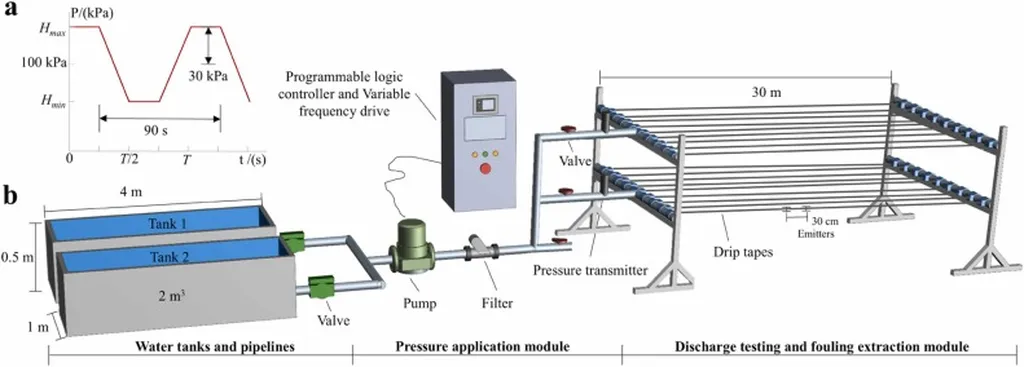In the quest for sustainable agriculture, researchers have long sought ways to optimize irrigation systems, particularly drip irrigation, which is renowned for its water efficiency. A recent study published in *Agricultural Water Management* sheds new light on how dynamic pressure (DP) and the type of drip tape can significantly impact the clogging of drip irrigation systems, offering promising insights for farmers and agritech innovators alike.
The study, led by Shaobo Xing from the College of Water Conservancy & Architectural Engineering at Shihezi University in China, investigated the effects of dynamic pressure and different types of drip tapes on the clogging of drip irrigation systems under integrated water and fertilizer conditions. The research team conducted an indoor experiment using water containing urea and river sand to evaluate the anti-clogging ability of three types of drip tapes under dynamic pressure compared to constant pressure.
The results were striking. Dynamic pressure was found to increase the time required for the discharge ratio of the drip system to decrease to 75% by 11.663%, and it exhibited a discharge ratio increase proportion of 32.242%. Moreover, the average increase proportion in Christiansen’s uniformity coefficient of irrigation (CU) was 21.785%, showing a positive correlation with the discharge ratio.
“Dynamic pressure obviously enhanced the anti-clogging ability of drip systems,” Xing noted. “Under dynamic pressure, non-pressure-compensated emitters with low nominal discharge and pressure-compensated emitters have higher anti-clogging ability.”
The implications for the agriculture sector are substantial. Clogging in drip irrigation systems can lead to uneven water distribution, reduced crop yields, and increased maintenance costs. By optimizing the type of drip tape and utilizing dynamic pressure, farmers can potentially enhance the longevity and efficiency of their irrigation systems, leading to more sustainable and productive agricultural practices.
“This research provides new guidelines for the long-term and stable application of dynamic pressure in drip systems,” Xing added. “It offers a practical approach to mitigate clogging issues, which can be a significant challenge for farmers.”
The study’s findings could pave the way for future developments in agritech, particularly in the design and implementation of more resilient and efficient irrigation systems. As the agriculture sector continues to grapple with water scarcity and the need for sustainable practices, innovations in drip irrigation technology will be crucial.
For farmers and agritech companies, the research highlights the importance of selecting the right drip tape and pressure conditions to maximize irrigation efficiency and minimize clogging. This could lead to the development of new products and technologies tailored to specific agricultural needs, ultimately benefiting both the environment and the bottom line.
As the agriculture sector looks to the future, the integration of dynamic pressure and advanced drip tape technologies could play a pivotal role in shaping more sustainable and efficient farming practices. The research led by Shaobo Xing from the College of Water Conservancy & Architectural Engineering at Shihezi University, published in *Agricultural Water Management*, offers a compelling glimpse into the potential of these innovations.

